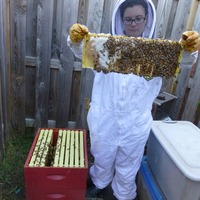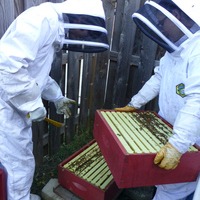It was a sunny autumn day and the medical campus was buzzing with activity.

Literally.
The student group Hopkins Honey was holding tours of their beehive and our group could hear the low hum of activity as we approached.
The hive is located in an enclosed fence between the Armstrong Building and the Caroline Garage on the JHMI Medical Campus. You may even have walked by it without noticing. Conveniently for the bees, the Hopkins Garden sits nearby, though the bees can travel up to a mile for their foraging.
Our intrepid guide, Corey Porter, a fifth-year graduate student in the pathobiology program, first got into beekeeping through Hopkins Honey.
"I think bees are really cool. And I think honey is really cool,” she said, explaining why she enjoyed being a part of the group. “My favorite part of being a member of Hopkins Honey is getting hands-on experience in a working beehive,” she added.

Our mission today: deliver some much needed sucrose solution (made with equal parts water and sugar) to help the hive produce more honey in preparation for winter, and to learn more about bees.
I couldn't resist donning a beekeeper's outfit when one was offered to me. Another student on the tour commented that we looked like we were in a scene straight out of 2001: A Space Odyssey.
The hive itself is basically a box made of two racks stacked atop one another, plus a covered tray to hold the sugar water. After removing the cover from the hive and checking the water, Corey removed a frame from the top rack. The frames are lined vertically inside the rack, spaced out like folders in a filing cabinet. But instead of holding papers, they contained tessellated hexagons of honeycomb, some capped with wax and covered in honey.
Plus, here were bees on them.
Lots and lots of fuzzy little bees.
The caps on the combs were darker on the bottom rack we removed, and Corey pointed out the bee larvae curled up inside of some of the uncapped honeycombs.Hopkins Honey was formed five years ago as part of a Bloomberg School of Public Health initiative to improve the public's awareness of the impact bees have in our lives. After all, bees pollinate one-third of our food sources and are an essential part of the ecosystem and our agricultural livelihood. However, in recent years, bees have been mysteriously dying off in masses.
Hopkins Honey is doing its part to combat this serious problem. Aside from maintaining this beehive for pollination, honey production and educational purposes, Hopkins Honey also organizes seminars about bees and the art of keeping them.
I was assured that to join the organization, no prior beekeeping experience is necessary, just an enthusiasm for bees. If you are interested in becoming a member of Hopkins Honey or to just kept abreast of bee-related news and happenings, email Corey to be added to the group’s mailing list or check out their Facebook group.